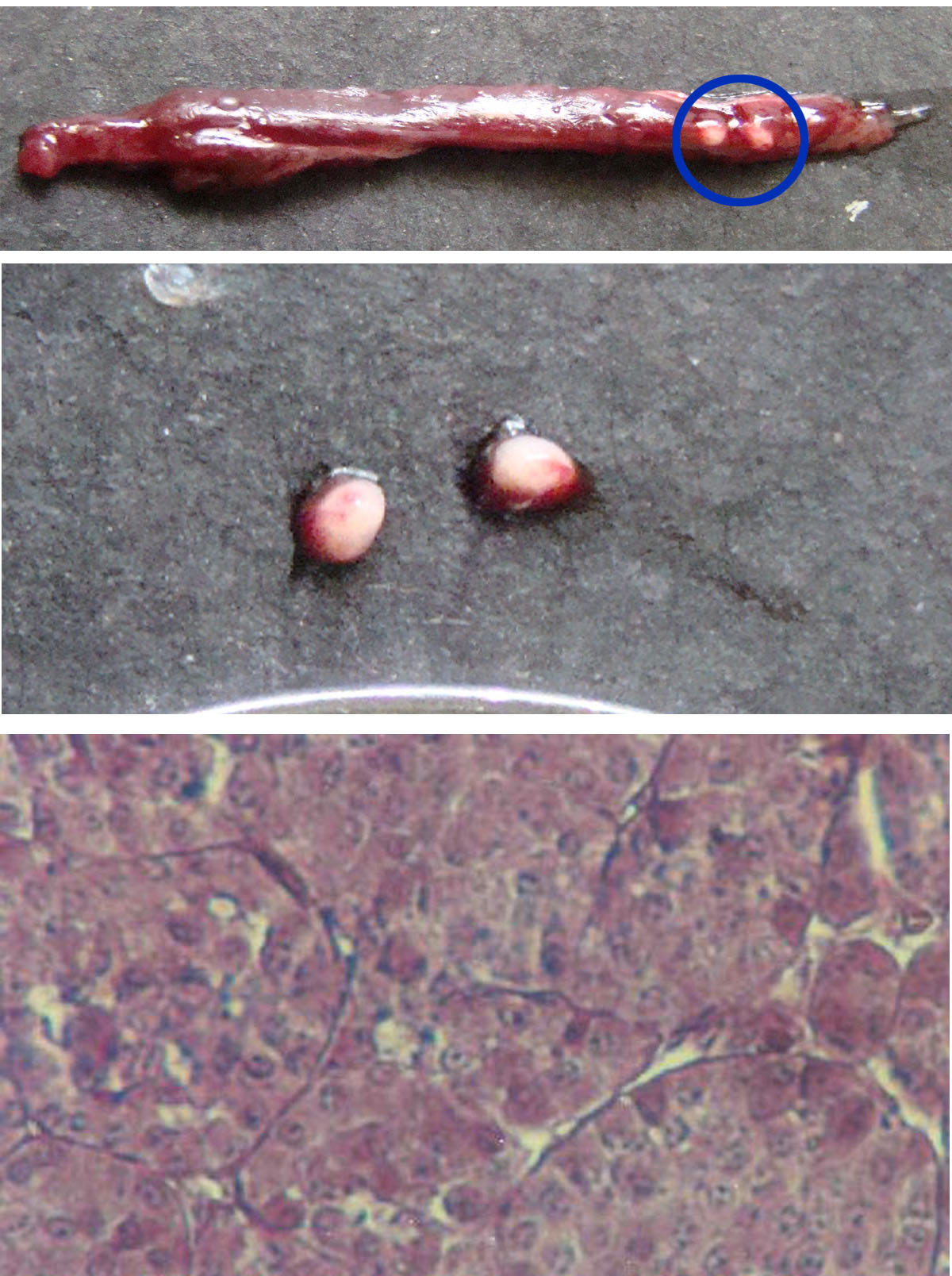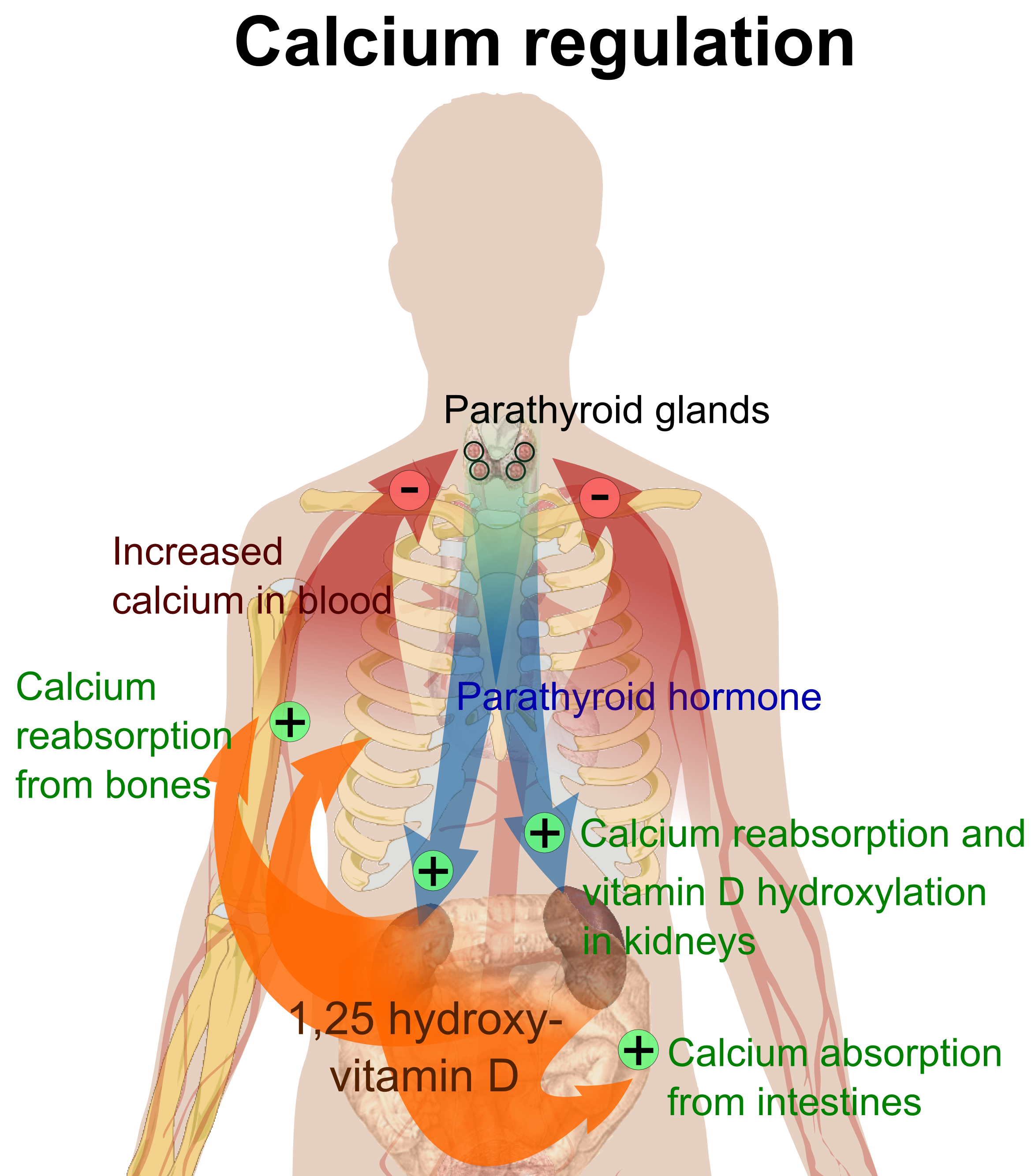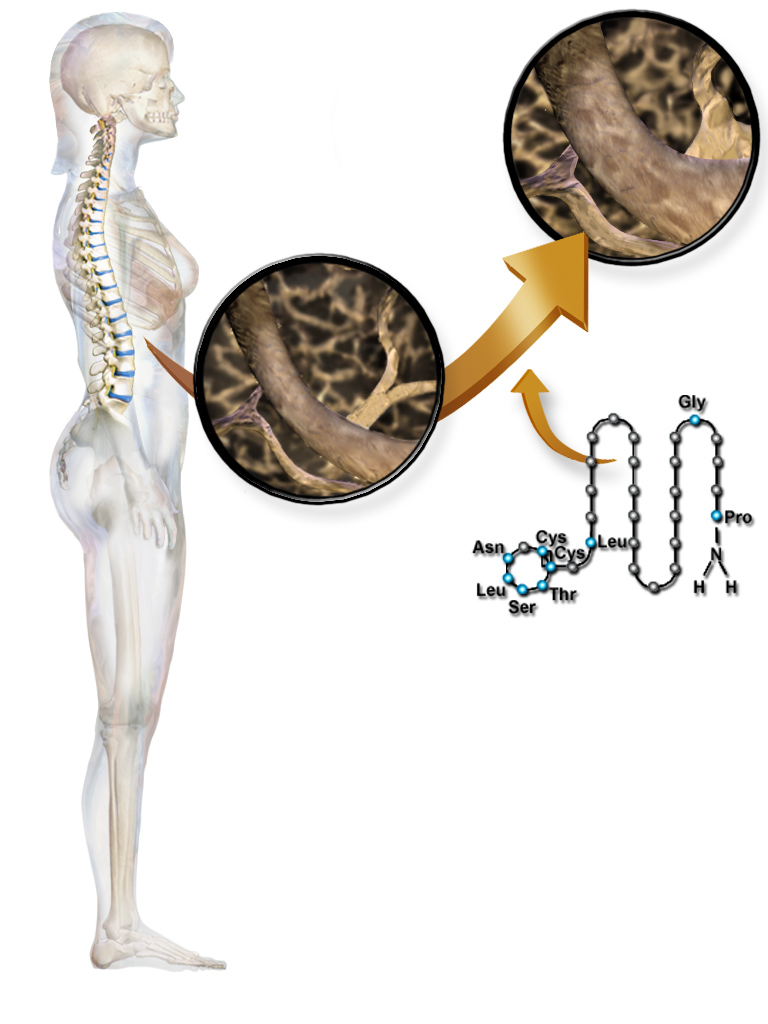|
Stanniocalcin
Stanniocalcin (originally named hypocalcin or teleocalcin or parathyrin) is a family of hormones which regulate calcium and phosphate balance in the body. The first stanniocalcin discovered was from fish and was identified as the principal calcium-reducing ( hypocalcaemic) factor. It was isolated from special organs in fish called corpuscles of Stannius, hence the name stanniocalcin. Chemically, stanniocalcins are glycosylated proteins (i.e. proteins containing carbohydrate, or glycoproteins) having a molecular mass of 50 kDa. They exist in molecular pairs (homodimers) and are joined together by disulfide linkage. Stanniocalcins are made up of approximately 250 amino acids. Discovery In 1839, the German anatomist Hermann Friedrich Stannius discovered a pair of novel structures inside the kidneys of sturgeon and bony fishes. He believed that they were a kind of adrenal gland (found in mammals) in these fishes. In 1896, the French physiologist A. Petit demonstrated that removal of ... [...More Info...] [...Related Items...] OR: [Wikipedia] [Google] [Baidu] |
STC1
Stanniocalcin-1 is a glycoprotein, a homologue of a hormone stanniocalcin, first discovered in bony fishes. In humans it is encoded by the ''STC1'' gene. Function This gene encodes a secreted, homodimeric glycoprotein that is expressed in a wide variety of tissues and may have autocrine or paracrine functions. The only known molecular function of human Stanniocalcin-1 to date is a SUMO E3 ubiquitin ligase activity in the SUMOylation cycle. However, STC1 interacts with many proteins in the cytoplasm, mitochondria, endoplasmatic reticulum, and in dot-like fashion in the cell nucleus. The N-terminal region of STC1 is the function region which is responsible to establish the interaction with its partners, including SUMO1. Low-resolution studies shows that STC1 is an anti-parallel homodimer in solution and the cysteine 202 is responsible for its dimerization. All the 5 disulfide bonds of human STC1 are conserved and have the same profile of fish STC. The gene contains a 5' UTR rich ... [...More Info...] [...Related Items...] OR: [Wikipedia] [Google] [Baidu] |
STC2
Stanniocalcin-2 is a protein that in humans is encoded by the ''STC2'' gene. This gene encodes a secreted, homodimeric glycoprotein that is expressed in a wide variety of tissues and may have autocrine or paracrine functions. The encoded protein has 10 of its 15 cysteine residues conserved among stanniocalcin family members and is phosphorylated by casein kinase 2 exclusively on its serine residues. Its C-terminus contains a cluster of histidine residues which may interact with metal ions. The protein may play a role in the regulation of renal and intestinal calcium and phosphate transport, cell metabolism, or cellular calcium/phosphate homeostasis. Constitutive overexpression of human stanniocalcin 2 in mice resulted in pre-and postnatal growth restriction, reduced bone and skeletal muscle growth, and organomegaly. Expression of this gene is induced by estrogen and altered in some breast cancers. Stanniocalcin reduces bone growth by modulating the activity o ... [...More Info...] [...Related Items...] OR: [Wikipedia] [Google] [Baidu] |
Corpuscles Of Stannius
The corpuscles of Stannius are special endocrine organs in the kidney in fish and are responsible for maintaining calcium balance. They are found only in bony fishes. They were discovered and described by a German anatomist Hermann Friedrich Stannius in 1839. Stannius considered them as functionally similar to adrenal glands in mammals. But they have later been found to be anatomically different as they are derived from different tissues of the embryo. Structurally the corpuscles are a large number of spherical bodies separated from each other by loose connective tissues. Each body or lobule is in turn composed of several columnar cells, which contain secretory granules and are, thus, secretory in function. Each Secretory granule is spherical in shape and measures 0.5 to 1 μm in diameter. Their possible endocrine nature, i.e. producing hormone, was suspected from the complete anatomical description, and it was believed to be responsible for regulating calcium level in the blood. ... [...More Info...] [...Related Items...] OR: [Wikipedia] [Google] [Baidu] |
Calcium Metabolism
Calcium metabolism is the movement and regulation of calcium ions (Ca2+) ''in'' (via the gut) and ''out'' (via the gut and kidneys) of the body, and ''between'' body compartments: the blood plasma, the extracellular and intracellular fluids, and bone. Bone acts as a calcium storage center for deposits and withdrawals as needed by the blood via continual bone remodeling. An important aspect of calcium metabolism is plasma calcium homeostasis, the regulation of calcium ions in the blood plasma within narrow limits. The level of the calcium in plasma is regulated by the hormones parathyroid hormone (PTH) and calcitonin. PTH is released by the chief cells of the parathyroid glands when the plasma calcium level falls below the normal range in order to raise it; calcitonin is released by the parafollicular cells of the thyroid gland when the plasma level of calcium is above the normal range in order to lower it. Body compartment content Calcium is the most abundant mineral in ... [...More Info...] [...Related Items...] OR: [Wikipedia] [Google] [Baidu] |
Calcitonin
Calcitonin is a 32 amino acid peptide hormone secreted by parafollicular cells (also known as C cells) of the thyroid (or endostyle) in humans and other chordates. in the ultimopharyngeal body. It acts to reduce blood calcium (Ca2+), opposing the effects of parathyroid hormone (PTH). Its importance in humans has not been as well established as its importance in other animals, as its function is usually not significant in the regulation of normal calcium homeostasis. It belongs to the calcitonin-like protein family. Historically calcitonin has also been called thyrocalcitonin. Biosynthesis and regulation Calcitonin is formed by the proteolytic cleavage of a larger prepropeptide, which is the product of the CALC1 gene (). It is functionally an antagonist with PTH and Vitamin D3. The CALC1 gene belongs to a superfamily of related protein hormone precursors including islet amyloid precursor protein, calcitonin gene-related peptide, and the precursor of adrenomedullin. Secretion of ... [...More Info...] [...Related Items...] OR: [Wikipedia] [Google] [Baidu] |
Fish Hormones
Fish are Aquatic animal, aquatic, craniate, gill-bearing animals that lack Limb (anatomy), limbs with Digit (anatomy), digits. Included in this definition are the living hagfish, lampreys, and Chondrichthyes, cartilaginous and bony fish as well as various extinct related groups. Approximately 95% of living fish species are ray-finned fish, belonging to the class Actinopterygii, with around 99% of those being teleosts. The earliest organisms that can be classified as fish were soft-bodied chordates that first appeared during the Cambrian period. Although they lacked a vertebrate, true spine, they possessed notochords which allowed them to be more agile than their invertebrate counterparts. Fish would continue to evolve through the Paleozoic era, diversifying into a wide variety of forms. Many fish of the Paleozoic developed placodermi, external armor that protected them from predators. The first fish with jaws appeared in the Silurian period, after which many (such as sharks) b ... [...More Info...] [...Related Items...] OR: [Wikipedia] [Google] [Baidu] |
Peptide Hormones
Peptide hormones or protein hormones are hormones whose molecules are peptide, or proteins, respectively. The latter have longer amino acid chain lengths than the former. These hormones have an effect on the endocrine system of animals, including humans. Most hormones can be classified as either amino acid–based hormones (amine, peptide, or protein) or steroid hormones. The former are water-soluble and act on the surface of target cells via second messengers; the latter, being lipid-soluble, move through the plasma membranes of target cells (both cytoplasmic and nuclear) to act within their nuclei. Like all peptides and proteins, peptide hormones and protein hormones are synthesized in cells from amino acids according to mRNA transcripts, which are synthesized from DNA templates inside the cell nucleus. Preprohormones, peptide hormone precursors, are then processed in several stages, typically in the endoplasmic reticulum, including removal of the N-terminal signal sequence an ... [...More Info...] [...Related Items...] OR: [Wikipedia] [Google] [Baidu] |
Adipocyte
Adipocytes, also known as lipocytes and fat cells, are the cells that primarily compose adipose tissue, specialized in storing energy as fat. Adipocytes are derived from mesenchymal stem cells which give rise to adipocytes through adipogenesis. In cell culture, adipocyte progenitors can also form osteoblasts, myocytes and other cell types. There are two types of adipose tissue, white adipose tissue (WAT) and brown adipose tissue (BAT), which are also known as white and brown fat, respectively, and comprise two types of fat cells. Structure White fat cells White fat cells contain a single large lipid droplet surrounded by a layer of cytoplasm, and are known as unilocular. The nucleus is flattened and pushed to the periphery. A typical fat cell is 0.1 mm in diameter with some being twice that size, and others half that size. However, these numerical estimates of fat cell size depend largely on the measurement method and the location of the adipose tissue. The fat stored i ... [...More Info...] [...Related Items...] OR: [Wikipedia] [Google] [Baidu] |
Leech
Leeches are segmented parasitic or predatory worms that comprise the subclass Hirudinea within the phylum Annelida. They are closely related to the oligochaetes, which include the earthworm, and like them have soft, muscular segmented bodies that can lengthen and contract. Both groups are hermaphrodites and have a clitellum, but leeches typically differ from the oligochaetes in having suckers at both ends and in having ring markings that do not correspond with their internal segmentation. The body is muscular and relatively solid, and the coelom, the spacious body cavity found in other annelids, is reduced to small channels. The majority of leeches live in freshwater habitats, while some species can be found in terrestrial or marine environments. The best-known species, such as the medicinal leech, ''Hirudo medicinalis'', are hematophagous, attaching themselves to a host with a sucker and feeding on blood, having first secreted the peptide hirudin to prevent the blood from c ... [...More Info...] [...Related Items...] OR: [Wikipedia] [Google] [Baidu] |
Atlantic Salmon
The Atlantic salmon (''Salmo salar'') is a species of ray-finned fish in the family Salmonidae. It is the third largest of the Salmonidae, behind Siberian taimen and Pacific Chinook salmon, growing up to a meter in length. Atlantic salmon are found in the northern Atlantic Ocean and in rivers that flow into it. Most populations are anadromous, hatching in streams and rivers but moving out to sea as they grow where they mature, after which the adults seasonally move upstream again to spawn. When the mature fish re-enter rivers to spawn, they change in colour and appearance. Some populations of this fish only migrate to large lakes, and are "landlocked", spending their entire lives in freshwater. Such populations are found throughout the range of the species. Unlike Pacific species of salmon, ''S. salar'' is iteroparous, which means it can survive spawning and return to sea to repeat the process again in another year. Such individuals can grow to extremely large sizes, althoug ... [...More Info...] [...Related Items...] OR: [Wikipedia] [Google] [Baidu] |
N-linked Glycosylation
''N''-linked glycosylation, is the attachment of an oligosaccharide, a carbohydrate consisting of several sugar molecules, sometimes also referred to as glycan, to a nitrogen atom (the amide nitrogen of an asparagine (Asn) residue of a protein), in a process called ''N''-glycosylation, studied in biochemistry. This type of linkage is important for both the structure and function of many eukaryotic proteins. The ''N''-linked glycosylation process occurs in eukaryotes and widely in archaea, but very rarely in bacteria. The nature of ''N''-linked glycans attached to a glycoprotein is determined by the protein and the cell in which it is expressed. It also varies across species. Different species synthesize different types of ''N''-linked glycan. Energetics of bond formation There are two types of bonds involved in a glycoprotein: bonds between the saccharides residues in the glycan and the linkage between the glycan chain and the protein molecule. The sugar moieties are linked t ... [...More Info...] [...Related Items...] OR: [Wikipedia] [Google] [Baidu] |
Sockeye Salmon
The sockeye salmon (''Oncorhynchus nerka''), also called red salmon, kokanee salmon, blueback salmon, or simply sockeye, is an anadromous species of salmon found in the Northern Pacific Ocean and rivers discharging into it. This species is a Pacific salmon that is primarily red in hue during spawning. They can grow up to in length and weigh . Juveniles remain in freshwater until they are ready to migrate to the ocean, over distances of up to . Their diet consists primarily of zooplankton. Sockeye salmon are semelparous, dying after they spawn. Some populations, referred to as kokanee, do not migrate to the ocean and live their entire lives in fresh water. Classification and name origin The sockeye salmon is the third-most common Pacific salmon species, after pink and chum salmon. ''Oncorhynchus'' comes from the Greek ὄγκος (onkos) meaning "barb", and ῥύγχος (rhynchos) meaning "snout". ''Nerka'' is the Russian name for the anadromous form. The name "sockeye" ... [...More Info...] [...Related Items...] OR: [Wikipedia] [Google] [Baidu] |







